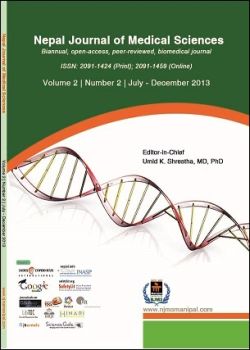Magnitude of ocular trauma in a tertiary care hospital of western Nepal
DOI:
https://doi.org/10.3126/njms.v2i2.8964Keywords:
Blindness, corneal laceration, ocular traumaAbstract
Background: Ocular injury is one of the major causes of monocular visual impairment and blindness worldwide, with significant socioeconomic impact. The present study was done to establish the incidence and identify the common causes of ocular trauma in a tertiary care hospital of western Nepal.
Methods: This is a cross-sectional study, conducted at a teaching hospital in western Nepal from January 2012 to January 2013. All ocular trauma cases attending emergency and eye OPD were included in the study. A complete history and detailed ophthalmological evaluation was done.
Results: Total number of cases was two hundred and nine. The incidence of ocular trauma was 1.74%. Average age of patients was 28.89±19.06 years. Maximum patients were from third decade of life and were males (66.5%). Majority of ocular trauma occurred in right eye and were sustained at the workplace. Only 2.4% of patients used protective agents. The cases presented to the hospital within 48 hours of injury were 71.8%. Maximum subjects didn’t use any medication before they presented to this hospital. Road traffic accident (RTA) was the commonest cause of ocular trauma followed by wood stick and fall injury.
Conclusion: Males are more prone to ocular trauma. As the commonest cause is RTA and very few patients used protective devices so public awareness about eye health program and strict legislation for the use of protective devices may help to reduce the magnitude of ocular injury.
Nepal Journal of Medical Sciences | Volume 02 | Number 02 | July-December 2013 | Page 140-143
Downloads
Downloads
Published
How to Cite
Issue
Section
License
Copyright © by Nepal Journal of Medical Sciences. The ideas and opinions expressed by authors of articles summarized, quoted, or published in full text in this Journal represents only opinions of authors and do not necessarily reflect the official policy of Nepal Journal of Medical Sciences or the institute with which the author(s) is (are) affiliated, unless so specified.




